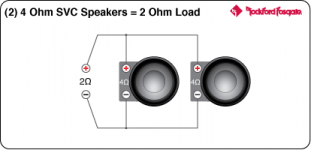Fairly quick question.
is it possible to connect my speakers in this way ( pic Below )
I have 4 4 ohm speaker I want to put 2 per channel. Is that possible ?
If you need more info please feel free to contact me and i will post an info you need to help me out.
Now I need not only an answer but a short explination so I never have to ask this again If you just say no I will be like ok And one day ask again cause I am forgetful like that LOL
Thanking all who read and answer this post to help me out.
is it possible to connect my speakers in this way ( pic Below )
I have 4 4 ohm speaker I want to put 2 per channel. Is that possible ?
If you need more info please feel free to contact me and i will post an info you need to help me out.
Now I need not only an answer but a short explination so I never have to ask this again If you just say no I will be like ok And one day ask again cause I am forgetful like that LOL
Thanking all who read and answer this post to help me out.
Attachments
if they are single 4ohm subs, and the amp can support 2ohm load for 2 channels, then yes, it is fine. it is ohms law parallel. (meaning each speaker pulls directly from the same signal) the calculation for any parallel is
( 1/r + 1/r ...etc = x/r, then flip) for your example, 1/4 + 1/4 = 2/4 =1/2 =2/1 = 2ohms. if you had 3 it would be 1/4+1/4+1/4=3/4=4/3= 1.33
( 1/r + 1/r ...etc = x/r, then flip) for your example, 1/4 + 1/4 = 2/4 =1/2 =2/1 = 2ohms. if you had 3 it would be 1/4+1/4+1/4=3/4=4/3= 1.33
you need to post the specs on the amplifer and speaker wattage
Hope this helps
RT251D
R
MS Power measured at 14.4 Volts DC:
100 Watts x 1 into a 4 Ohm load with less than 1% Thd+N
200 Watts x 1 into a 2 Ohm load with less than 1% Thd+N
Dynamic Power measured at 14.4 Volts DC:
125 Watts x 1 into a 4 Ohm load
250 Watts x 1 into a 2 Ohm load
Signal to Noise Ratio:
≥100dB A-Weighted
Frequency Response:
20Hz-85Hz
Maximum Input:
8Vrms
Bass Boost:
Switchable Bass Boost 0, 6, or 12dB centered at 40Hz
Crossover:
Fixed @ 85Hz, 18dB/octave low pass
Dimensions:
Including Iso-Feet™
7.98" x 9.75" x 2.1" (20.3cm x 24.8cm x 5.3cm)
You will have problems, because that amplifier is MONO (ONE CHANNEL) even though it has two output channels (their mono inside). So if you do the wiring as you stated you will end up with a final load of 1-ohm which will instantly kill the amplifier (well not right away maybe in a minute or two).
Now if you wire one set of speakers SERIES you'll have an 8-ohm load on each set of speakers (two 8-ohm loads) then when you hook those to your amplifier one on each side/channel your amplifier will see a final load of 4-ohms.
OR
Keep each pair PARALLEL so you'll have 2-ohm per set, then from one set hook the negative to the positive of the other set, then the positive and negative thats left over to the amplifier (THE AMPLIFIER WILL STILL HAVE A FINAL 4-ohm load either way it goes).
But keeping it 4-ohms will make sure your amplifier will play for hours with out problems.
I can post pics/examples if you need me too.
Now if you wire one set of speakers SERIES you'll have an 8-ohm load on each set of speakers (two 8-ohm loads) then when you hook those to your amplifier one on each side/channel your amplifier will see a final load of 4-ohms.
OR
Keep each pair PARALLEL so you'll have 2-ohm per set, then from one set hook the negative to the positive of the other set, then the positive and negative thats left over to the amplifier (THE AMPLIFIER WILL STILL HAVE A FINAL 4-ohm load either way it goes).
But keeping it 4-ohms will make sure your amplifier will play for hours with out problems.
I can post pics/examples if you need me too.
You will have problems, because that amplifier is MONO (ONE CHANNEL) even though it has two output channels (their mono inside). So if you do the wiring as you stated you will end up with a final load of 1-ohm which will instantly kill the amplifier (well not right away maybe in a minute or two).
Now if you wire one set of speakers SERIES you'll have an 8-ohm load on each set of speakers (two 8-ohm loads) then when you hook those to your amplifier one on each side/channel your amplifier will see a final load of 4-ohms.
OR
Keep each pair PARALLEL so you'll have 2-ohm per set, then from one set hook the negative to the positive of the other set, then the positive and negative thats left over to the amplifier (THE AMPLIFIER WILL STILL HAVE A FINAL 4-ohm load either way it goes).
But keeping it 4-ohms will make sure your amplifier will play for hours with out problems.
I can post pics/examples if you need me too.
Pictures would be fabulous Iam a more visual type of guy ya know.
- Status
- This old topic is closed. If you want to reopen this topic, contact a moderator using the "Report Post" button.
- Home
- General Interest
- Car Audio
- Just a little Help Please
